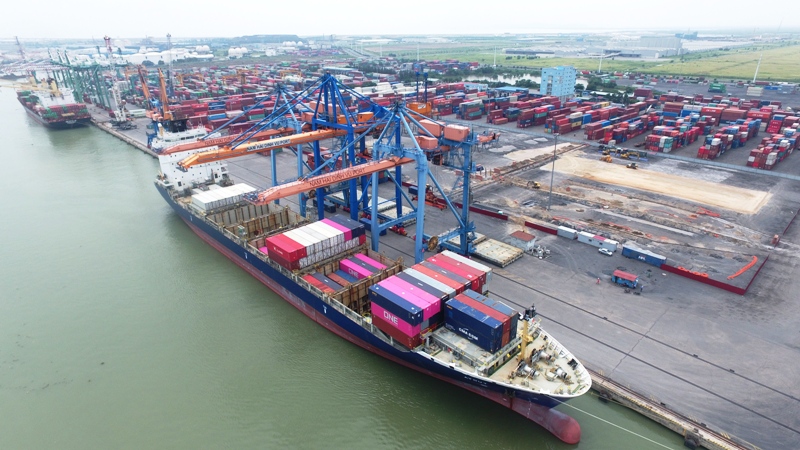Vietnam exports surge over 25% to US$186 billion in 7-month period
The current Covid-19 outbreak has inevitably caused a sharp drop in consumer spending and a potential rise in living costs, but exports remained a driving force for growth with consistent performance.
Vietnam’s exports surged 25.5% year-on-year in the January-July period to US$185.33 billion, with the foreign-invested sector making up 73.8% of the total at $136.81 billion, the General Statistics Office (GSO) has said in a monthly report.
| Haiphong Port. Photo: Pham Hung |
The domestic sector also saw positive growth in exports by 14.6% year-on-year to $48.52 billion, or 26.2% of the total.
According to the GSO, the manufacturing and processing sector contributed a lion’s share in the country’s exports by $165 billion, followed by agroforestry at $13.65 billion, and seafood ($4.92 billion).
In the seven-month period, the US remained Vietnam’s largest export market, while China and the EU claimed the second and third spots.
In return, Vietnam imported goods and products worth $188 billion during the period, representing an increase of 35.3% year-on-year. This resulted in a trade deficit of $2.7 billion in seven months, which stood in stark contrast with a surplus of $8.7 billion in the same period of last year.
China continued to be Vietnam's largest supplier by selling US$62.3 billion worth of goods, surging 49% year on year. South Korea came in second for $29.7 billion, up 20%, and ASEAN at third ($24.7 billion).
Consumer spending drops by 20%
Total retail sales of consumer goods and services in Vietnam reached an estimated VND3339.4 trillion (US$14.7 billion) in July, down 19.8% against the same period last year.
“The pandemic caused severe impacts on trade, transportation, and tourism as many southern provinces/cities are under social distancing orders,” stated the statistics agency.
In July, passenger transportation recorded a 50.4% contraction year-on-year in the number of passengers with 146.3 million and 24.3% in goods, or 111.5 million tons.
Despite such declines, the retail sales figure in the seven-month period remained positive at VND2,791 trillion ($121.5 billion), up 0.7% year-on-year.
To further support the retail market in the coming months, the Ministry of Industry and Trade (MoIT) is set to carry out promotional programs to stimulate demand and prioritize domestic consumption.
Amid the pandemic, the MoIT stressed the focus of applying IT and shifting to e-commerce to boost trade.
Vietnam living costs stay at 5-year low
Vietnam's consumer price index (CPI), the main gauge of inflation, in July saw a slight increase of 0.62% against the previous month and 2.64% year-on-year.
This resulted in an increase of 1.64% year-on-year for the January-July period, the lowest seven-month growth rate since 2016.
Impacts of the Covid-19 pandemic, sharp rise in fuel prices in line with the global market and growing consumer demand for electricity in the summer led to an increase in the CPI in July, stated the GSO.
Seven out of 11 commodity groups, which are components of the basket for CPI calculation, witnessed a month-on-month increase in prices. Among them, transportation posted the strongest rise of 2.36% as a result of 12 fuel price adjustments since the beginning of the year, followed by housing, water and electricity supply, and construction materials (0.88%); food and catering services (0.67%).
Three groups that saw their prices down in July were culture, entertainment, and tourism (-0.1%); post and telecommunications (-0.05%); and garment, footwear, and hats (-0.03%).
According to the GSO, the core inflation rate in July went down 0.06% month-on-month, resulting in an increase of 0.99% year-on-year. For the seven-month period, the inflation rate rose by 0.89% against the same period of last year.
Former GSO Director Nguyen Bich Lam said the serious Covid-19 situation and subsequent restriction measures would further complicate economic activities in the remaining months of the year.
“CPI for the upcoming five months may increase at a much higher pace compared to that of July”, added Lam, but expecting the CPI to stay in line with the target of 3.3-3.6% set by the National Assembly.
Hanoi CPI expanded by 0.73% in July against last month and 2.28% year-on-year, putting the growth rate for the seven-month period at 1.30% year-on-year. To ensure a sufficient supply of basic necessities for the locals, the Hanoi Department of Industry and Trade has been working with retailers in the city to increase the inventory of goods and products by 30-50% for a total of VND194 trillion ($8.45 billion). A report from the Department also suggested retailers have stockpiled basic goods of VND5.7 trillion ($249 million) under the market stabilization program. |












